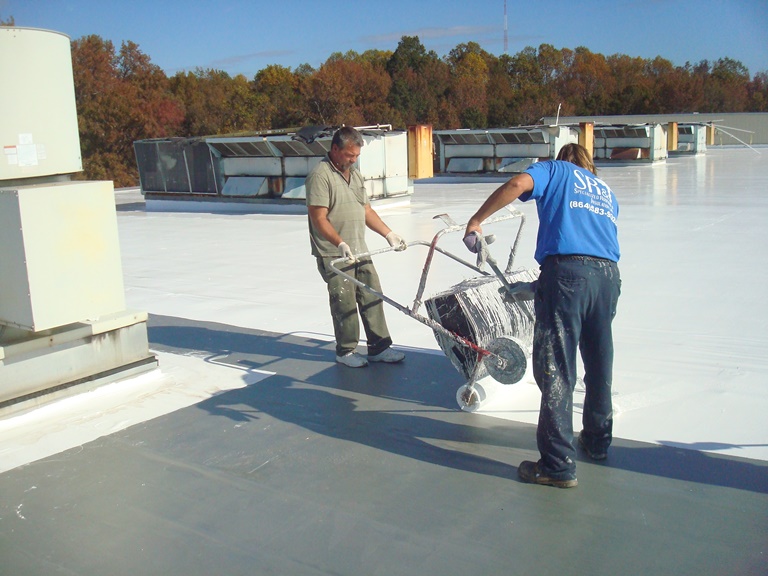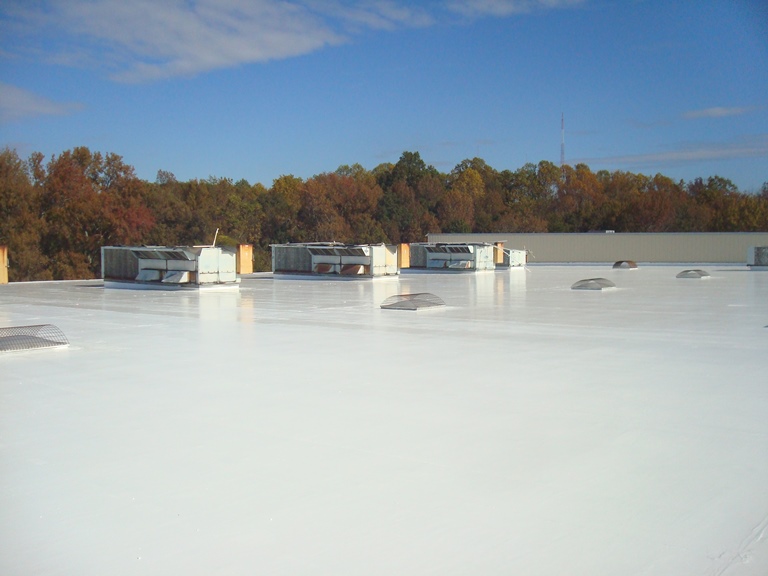Is there ever a good use of the word “leak”? No one enjoys a car window, a sink pipe, or even a water glass that leaks. Certainly roofs can be added to that category of things you don’t want to leak in the night. So when the 161,500-square-foot (15,003.8 m²) three-area roof of a supply building leaked, it was time to get Mr. Fix-It on the job. In this case, that meant Hal Hall of Specialized Roofing & Insulation, Inc. He’d use a six-person crew and a specialty coating system to get the job done.
Spray Inside the Lines
Staying inside the safety warning line system around the edge of the roof, the crew started by cleaning off the thermoplastic polyolefin (TPO) and modified bitumen roof areas. They completed one roof at a time to allow for efficiency and quality control, and they started by removing the dirt and debris using high-pressured air. Water wasn’t used because, in Hall’s words, “we were concerned we might damage the TPO membrane using a pressure washer due to its age and condition, so low-pressure water wash and high-pressure air were used to clean the TPO roof.” The crew used a trailer-mounted compressor from Ingersoll-Rand for the air cleaning and a 4,000-psi (27.6 MPa), contractor-grade pressure washer by Graco for the modified bitumen sections.
It took 11 days to prep each roof. Each day, the crew blew off the day’s designated area with a nine-horsepower motorized blower on wheels called a Billy Goat and multiple Husqvarna 50CC backpack blowers. Part of the prep also included repairing areas that had loose seams or patches, such as on the modified roof sections where they used a BASF foam to repair and patch. At one point, where the three roofs came together, a constant leak problem had been created where the roofs had settled. To “settle” that issue, the crew sprayed the foam to help build up the area and divert the water to the drains. That, and all other seams, then received a layer of ALDOCOAT 385 Polyurethane Aluminum Seam Seal.
Finally, the two-coat system was ready to go down. Wearing protective suits, goggles, gloves, and respirators (as required), the crew started with the basecoat. It took seven days to apply the layer of ALDOCOAT 384 Polyurethane Aluminum at an average of 14 mils (355.6 microns) dry film thickness (DFT). Instead of spraying the coating onto the roof, the crew chose to apply it using a 40-inch (101.6 cm) coating spreader.
“The coating itself is so thick and while it is sprayable it can be difficult to clean up, can clog the hoses and spray guns, and increase the maintenance on spray equipment as the product is also air- and moisture-cured,” Hall explained. “You can spray these products if you can clean your spray rig, pumps, pick-up lines, and hoses effectively at the end of each day and leave solvents in the hose overnight.” Instead, they had one person handling the spreader, two people backrolling the coating, and two people prepping the five-gallon (18.9 L) buckets to load into the hopper. “Using the spreader saves us a lot of time,” Hall continued. “We’re able to roll the products out much easier and quicker and get a consistent application coverage.”

Rain, Rain Go Away
Part of working on a rooftop means working at and with heights. Although the crew didn’t need to wear fall protection except when working outside of the perimeter warning lines, they did have to work with getting up top. “We staged the material on the roof in an organized manner to reduce time required getting material to the hopper where they’re working,” Hall said. They used pull wagons to get the pails to the hopper.
On this leaky roof project, another one of the challenges that this crew encountered, coincidentally, was rain. “Our area experienced a nine-day period of heavy rains and subsequently having several days of misting rain that hindered progress,” said Hall. Altogether, the weather caused a total of 15 days in delays.
“You can’t apply either product with the substrate being wet, so a lot of days we’d go out there in either frost or rain, we’d have to dry before we could start,” Hall explained. “That prolonged us a bit because we couldn’t work ‘til noon. Until the sun came up and you had it dry, it was 11 o’clock.”
Another highly regulated activity on the jobsite was smoking; there was a strict no-smoking policy on the roof and around material because some of the products that the Specialized Roofing crew used were flammable. “A designated smoking/break area was established on the ground away from our material laydown area,” Hall explained.
So when the rain wasn’t falling and the crew was up top, they moved onto the final coat: ALDOCOAT 395 Silicone Coating. It again took seven hours for the crew to apply that across the entire roof. The silicone coating also crossed curbs and penetration flashings — all at a rate of 1.5 gallons (5.7 L) per square foot (0.09 m²) to reach an average of 18 mils (457.2 microns).
Both the topcoat and basecoat took 24 hours for the coatings to cure. Also like the basecoat, the crew used a coating spreader, but they were sure to use different vats for the topcoat than the one they used for the basecoat so they didn’t accidentally mix any of the uncured coatings in the hoppers.
Bright White
At the end of the job, the client was left with a gleaming new roof. “It was very, very white,” Hall said. Although the roof has dulled a little bit due to being nearby a major interstate and other facilities, with a power wash, it can be brought back to looking brand new. “We’ve had to go help the client repair some damage around HVAC [heating, ventilation, and air conditioning] curbs where they took out some HVAC units,” Hall said. “We pressure washed the area to do that, and it turned instantly bright white again. That’s how we know it will.” On this job, the proof was in the roofing.
